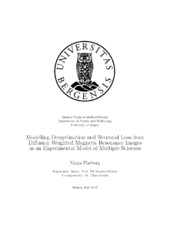| dc.description.abstract | This master project is an application of an advanced biophysical model of water diffusion in tissue to asses neuronal microstructure of mouse and rat brain and, in particular, to find potential imaging markers of demyelination and neuronal integrity. The model is applied to animals at different stages of cuprizone exposure, which models the demyelination of neurons caused by multiple sclerosis (MS). This is the first time the model has been applied to study MS. While the changes in white matter microstructure in MS have been extensively studied, lesions causing demyelination of gray matter are also present in the disease. In mouse brains, cuprizone exposure has been shown to induce demyelination and oligodendrocyte degeneration similar to that occurring in these lesions. Through conventional diffusion weighted imaging (DWI) sequences one is able to probe the microstructure of the brain tissues and detect changes such as MS lesions, but they are not pathologically specific. The complex biophysical model applied in the thesis is based on a DWI sequence to very high b- values, which allows probing on a micrometer scale. The diffusion weighted signal is modelled as a sum of the contribution from dendrites and axons (collectively named neurites) with cylindrical symmetry, and the extracellular space with spherical diffusion symmetry. In mouse and rat brains, the neurite density, and the longitudinal and extracellular diffusion coefficients estimated from the model were used to quantify the extent of demyelination in corpus callosum, deep gray matter and the cortex. In all regions of the mouse brains, the neurite density was found to decrease significantly with cuprizone expsure. The longitudinal diffusion coefficient, and thus the diffusivity in neurites, showed a corresponding increase. In addition there was a significant increase in the extracellular diffusion coefficient in the corpus callosum of cuprizone exposed brains. In all regions a significant increase in neurite density 4 weeks after ended exposure to cuprizone was shown. In all regions the neurite densities were shown to correlate well with the myelin levels estimated from histology. However, they were not found to correlate with the axon development of gray matter. In all regions, the neurite density and the longitudinal diffusion coefficient correlated with the estimated ADC from conventional diffusion modelling of the same brains. In both the cortex and deep gray matter, the complex model was able to detect significant changes in the neurite density, which was supported by the estimated myelin content from histology. While the same trend was seen in the ADC, the changes were not at a significant level. In the rat brains, no significant changes in any of the imaging parameters were detected in any of the defined regions of interest. Both histology and gene expression analysis of animals from the same project showed a clear demyelination, and reduction of myelin-related proteins in the upper layers of the cortex. The results from this project show that the model is suited for quantifying demyelination in the gray matter of mouse brains when cuprizone is used to model multiple sclerosis. In gray matter, it was found to be more specific and sensitive than conventional diffusion modelling. However, the results from rats show that the model is not as sensitive to smaller changes as histological examinations are. | en_US |
